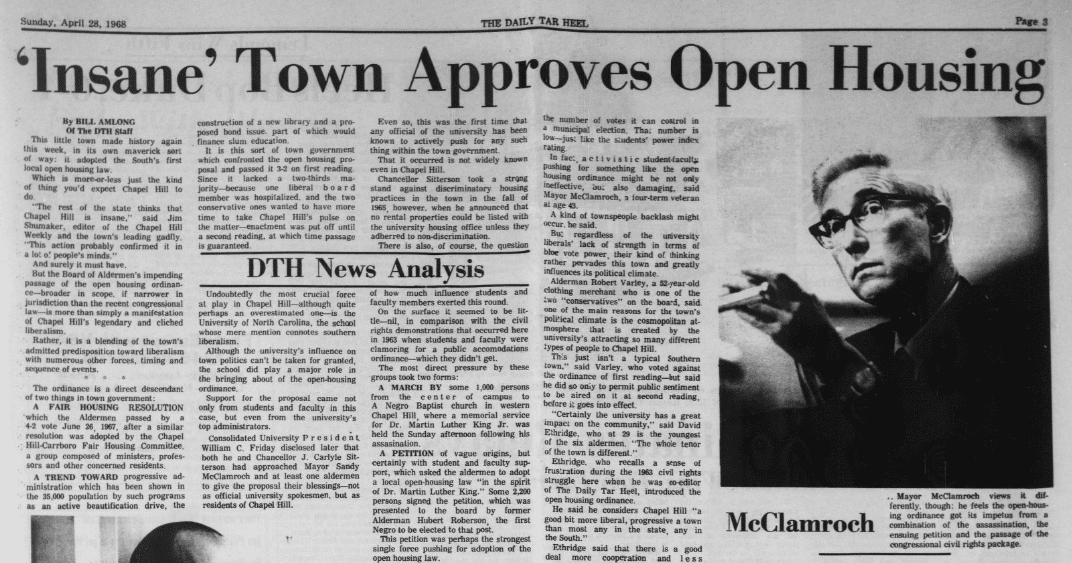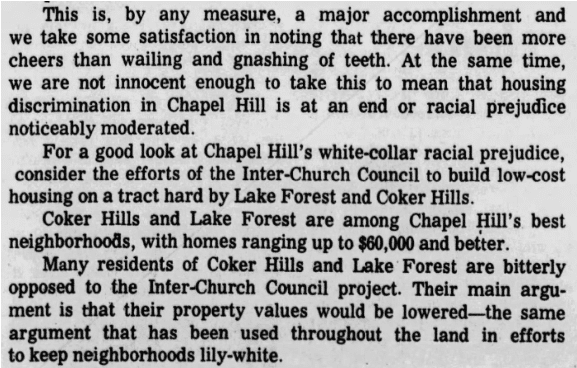We are publishing a six-part series looking back at Chapel Hill in 1968, and the lengthy and contentious battle to build duplexes and small apartments next to a church, and between a neighborhood of single-family homes and a shopping center.
Part 1: In-Chu Co and Missing Middle Housing: Chapel Hill’s Missing Middle Housing Battle in 1968
Part 2: In-Chu-Co: The protests start in 1968
Part 3: A push to build In-Cho-Co in Chapel Hill: ‘Is all of this Town’s vaunted liberalism phony?’
Part 4: Chapel Hill, 1968: The Death of Elliott Woods?
Part One: In May of 1968, the town of Chapel Hill made history. After years of debate, the town passed an “open housing law,” which banned racial discrimination in the “sale, leasing or rental of all housing,” making it the first municipality in the South to do so. Some of the law’s provisions were newly unnecessary due to the April 1968 passage of the Fair Housing Act. The Fair Housing Act prohibited discrimination concerning the sale, rental, and financing of housing based on race, religion, national origin, sex, (and as amended) handicap and family status.
But the federal legislation exempted owner-occupied buildings with no more than four units and single-family houses sold or rented by the owner without the use of an agent. Chapel Hill’s ordinance did not. Not everyone approved.

Weekly and the town’s leading gadfly. “This action probably confirmed it in a lot of people’s minds.”
And this wasn’t all that was changing.
After winning a council endorsement in March, the Inter-Church Council, an anti-poverty organization formed in 1963, was preparing to apply for federal funding to build 100 town homes for low-income individuals and families in Chapel Hill. The ICC selected Adelaide Walters, a former member of the town council, to head their housing campaign. Through a successful lobbying effort, Walters convinced the town to commit money to help families afford the homes that would be built or purchased.
![[Headline of December 15, 1968 issue of the Chapel Hill Weekly, Page 1-B. Top headline: Inter-Church Council for Social Service. Second headline: New Weapon to Blunt the Edge of Poverty. Subhead: The Helping Hands Are Coupled with Renewal and Rehabilitation. Picture on the right half of the page, beneath the top headline, is a portrait of nine officer of the ICC.]](https://triangleblogblog.com/wp-content/uploads/2023/03/Screenshot-2023-03-06-at-12-33-00-The-Chapel-Hill-weekly.-Chapel-Hill-N.C.-1923-1972-December-15-1963-B-Page-Page-1-B-Image-7.png)
The ICC also had a thoughtful approach to where it would build its homes. Rather than locating all of the housing in a single neighborhood, the ICC decided to focus its efforts on small sites, including a two-acre piece of land near Northside School, and a five-acre site near the Eastgate Shopping Center. The five acre site was owned by the Church of Reconciliation, whose members voted unanimously to allow some of their land to be developed for this purpose. The ICC planned to build 39 homes on the land, mostly “garden-type apartments in buildings made up of row houses, flats, and duplexes.” Working with experienced architects and planners, the ICC expected its townhouses to be “visually superior to much of the private apartment development now taking place.”
Despite these positive early signs, it was already clear that the project was not going to be received with enthusiasm by all. Neighbors in Coker Hills and Lake Forest voiced concern about the potential negative impacts on their property values if this project were to be built, despite the fact that similar projects in other communities had not had this effect. However, many thought that the ICC’s strong connections to the community—the organization was a collaborative project of eighteen local churches—would reassure everyone involved that this would be a high quality project.
Despite the ICC’s seeming optimism, others saw a tough fight ahead. In the same issue where the ICC’s proposal was discussed, the already-legendary editor of the Chapel Hill Weekly, James Shumaker, wrote an opinion piece in which he argued that this project would expose the tensions between Chapel Hill’s theoretical liberalism and its practical conservatism. He praised the open housing act, but wondered if Chapel Hill residents would really accept its implications.

![What the protestors really mean is they don't want poor folks living near them; it makes them uncomfortable. Neither do they want Negroes, even rich ones, living in their midst, which also would make them uncomfortable. And if there's anybody. they don't want around it's one who is both poor and black.
Ironically enough, some of those Coker Hills and Lake Forest residents protesting the black invasion are the same folks who have applauded Chapel Hill's open housing law, supported public housing projects here, and generally have bled, over cocktails, for the poor. oppressed. They want to see integration happen, even residential integration. They really do. They just don't want to see it happen to them.
For our part, we have more respect for the howling redneck who says "Hell no" to everything that smacks of racial equality. At least we know where he stands.]](https://triangleblogblog.com/wp-content/uploads/2023/03/Screenshot-2023-03-06-at-12-36-59-In-Chu-Co-Missing-Middle-Housing.png)
With donated land, a federal funding source, and strong community support for the project, only one final hurdle needed to be crossed. The land was zoned for “agricultural” purposes, so the ICC needed to get a special permit from the town before they could apply for funds.The Chapel Hill Town Council and the Planning Board were set to review the proposal on May 27, 1968.
![[Image of the excerpts of the Minutes of the Board of Alderman, Town of Chaple Hill, undated. The text reads: “The Board of Aldermen mot at a special quarterly hearing with the Planning Board on Monday May 27, 1968 at 7:30 p.m. with the following members present: Mayor McClamroch; Alderman Prothro, Giduz, Smith Varley, Ethridge and Kage. Planning Board members present were Tuttle, Fitch, Cleaveland, Scross, Welsh, Unstead, Wilson, Wallaco, Weiss, and Kyle. Also present were Town Manager Peck, Town Clerk Roberts and Town Attorney Denny.]](https://triangleblogblog.com/wp-content/uploads/2023/03/Screenshot-2023-03-06-at-12-38-43-680527_SQH.pdf.png)
Would the Town of Chapel Hill endorse building duplexes and small apartments next to a church, and between a neighborhood of single-family homes and a shopping center? Or would it deny the request?